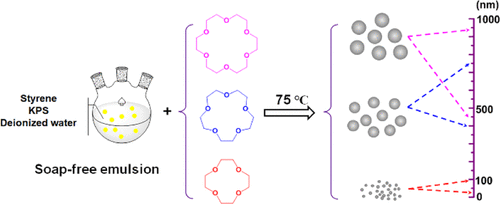当前位置:
X-MOL 学术
›
ACS Appl. Nano Mater.
›
论文详情
Our official English website, www.x-mol.net, welcomes your feedback! (Note: you will need to create a separate account there.)
Crown Ether-Assisted Synthesis of Polystyrene Nanoparticles: Implications for Biomedicine and Electronics
ACS Applied Nano Materials ( IF 5.9 ) Pub Date : 2020-11-02 , DOI: 10.1021/acsanm.0c02100 Meng-Qi Chen 1 , Wen-Shu Peng 1 , Yang-Yang Lin 1 , Hong-Liang Gu 1 , Yong-Jun Sun 1 , Bing-Qi Zhu 1 , Jing Li 1 , Jian-Guo Liu 1 , Jian-Bo Qu 1
ACS Applied Nano Materials ( IF 5.9 ) Pub Date : 2020-11-02 , DOI: 10.1021/acsanm.0c02100 Meng-Qi Chen 1 , Wen-Shu Peng 1 , Yang-Yang Lin 1 , Hong-Liang Gu 1 , Yong-Jun Sun 1 , Bing-Qi Zhu 1 , Jing Li 1 , Jian-Guo Liu 1 , Jian-Bo Qu 1
Affiliation

|
Monodisperse polystyrene (PS) nanoparticles with widely tunable sizes (30–930 nm) were prepared by soap-free emulsion polymerization with the assistance of crown ethers. The effects of crown ether species and concentrations, initiator species, and monomer contents on the sizes of PS nanoparticles were investigated in detail. The presence of 18-crown-6 and 15-crown-5 in the reaction system will facilitate the polymerization rate of styrene and produce larger PS nanoparticles in comparison with the control group (without crown ethers), whereas the system with 12-crown-4 retards the polymerization rate significantly and brings the smallest PS nanoparticles. As the interface of monomer/water is the main locus of initial reaction for the thermally initiated emulsion polymerization, the crown ether/alkali complexes accumulated around the styrene/water phase play both catalyst and molecular fence roles in the styrene soap-free emulsion polymerization. The former promotes and the latter inhibits the growth of PS nanoparticles. The relative contribution of these functions ultimately determines the final particle size. The results indicate that particle nucleation in styrene soap-free emulsion polymerization in the presence/absence of crown ethers occurs via an aggregative nucleation mechanism. This study provides a facile method to synthesize nanoparticles with widely tunable sizes via soap-free emulsion polymerization with the help of crown ethers, which has great potentials in biomedical and electronic fields.
中文翻译:

冠醚辅助合成聚苯乙烯纳米粒子:对生物医学和电子学的启示
在冠醚的帮助下,通过无皂乳液聚合制备了可广泛调节尺寸(30-930 nm)的单分散聚苯乙烯(PS)纳米颗粒。详细研究了冠醚种类和浓度,引发剂种类和单体含量对PS纳米粒子尺寸的影响。与对照组(不含冠醚)相比,反应体系中18-crown-6和15-crown-5的存在将促进苯乙烯的聚合速率并产生更大的PS纳米颗粒。 4显着延迟聚合速率并带来最小的PS纳米颗粒。由于单体/水的界面是热引发乳液聚合反应初始反应的主要场所,苯乙烯/水相周围积累的冠醚/碱配合物在无苯乙烯皂乳液聚合中同时起催化剂和分子围栏的作用。前者促进而后者抑制PS纳米颗粒的生长。这些功能的相对贡献最终决定了最终的粒径。结果表明,在存在/不存在冠醚的情况下,无苯乙烯皂乳液聚合中的颗粒成核是通过聚集成核机制发生的。这项研究提供了一种简便的方法,可在冠醚的帮助下通过无皂乳液聚合合成大小可调的纳米颗粒,这在生物医学和电子领域具有巨大的潜力。前者促进而后者抑制PS纳米颗粒的生长。这些功能的相对贡献最终决定了最终的粒径。结果表明,在存在/不存在冠醚的情况下,无苯乙烯皂乳液聚合中的颗粒成核是通过聚集成核机制发生的。这项研究提供了一种简便的方法,可在冠醚的帮助下通过无皂乳液聚合合成大小可调的纳米颗粒,这在生物医学和电子领域具有巨大的潜力。前者促进而后者抑制PS纳米颗粒的生长。这些功能的相对贡献最终决定了最终的粒径。结果表明,在存在/不存在冠醚的情况下,无苯乙烯皂乳液聚合中的颗粒成核是通过聚集成核机制发生的。这项研究提供了一种简便的方法,可在冠醚的帮助下通过无皂乳液聚合合成大小可调的纳米颗粒,这在生物医学和电子领域具有巨大的潜力。结果表明,在存在/不存在冠醚的情况下,无苯乙烯皂乳液聚合中的颗粒成核是通过聚集成核机制发生的。这项研究提供了一种简便的方法,可在冠醚的帮助下通过无皂乳液聚合合成大小可调的纳米颗粒,这在生物医学和电子领域具有巨大的潜力。结果表明,在存在/不存在冠醚的情况下,无苯乙烯皂乳液聚合中的颗粒成核是通过聚集成核机制发生的。这项研究提供了一种简便的方法,可在冠醚的帮助下通过无皂乳液聚合合成大小可调的纳米颗粒,这在生物医学和电子领域具有巨大的潜力。
更新日期:2020-11-25
中文翻译:

冠醚辅助合成聚苯乙烯纳米粒子:对生物医学和电子学的启示
在冠醚的帮助下,通过无皂乳液聚合制备了可广泛调节尺寸(30-930 nm)的单分散聚苯乙烯(PS)纳米颗粒。详细研究了冠醚种类和浓度,引发剂种类和单体含量对PS纳米粒子尺寸的影响。与对照组(不含冠醚)相比,反应体系中18-crown-6和15-crown-5的存在将促进苯乙烯的聚合速率并产生更大的PS纳米颗粒。 4显着延迟聚合速率并带来最小的PS纳米颗粒。由于单体/水的界面是热引发乳液聚合反应初始反应的主要场所,苯乙烯/水相周围积累的冠醚/碱配合物在无苯乙烯皂乳液聚合中同时起催化剂和分子围栏的作用。前者促进而后者抑制PS纳米颗粒的生长。这些功能的相对贡献最终决定了最终的粒径。结果表明,在存在/不存在冠醚的情况下,无苯乙烯皂乳液聚合中的颗粒成核是通过聚集成核机制发生的。这项研究提供了一种简便的方法,可在冠醚的帮助下通过无皂乳液聚合合成大小可调的纳米颗粒,这在生物医学和电子领域具有巨大的潜力。前者促进而后者抑制PS纳米颗粒的生长。这些功能的相对贡献最终决定了最终的粒径。结果表明,在存在/不存在冠醚的情况下,无苯乙烯皂乳液聚合中的颗粒成核是通过聚集成核机制发生的。这项研究提供了一种简便的方法,可在冠醚的帮助下通过无皂乳液聚合合成大小可调的纳米颗粒,这在生物医学和电子领域具有巨大的潜力。前者促进而后者抑制PS纳米颗粒的生长。这些功能的相对贡献最终决定了最终的粒径。结果表明,在存在/不存在冠醚的情况下,无苯乙烯皂乳液聚合中的颗粒成核是通过聚集成核机制发生的。这项研究提供了一种简便的方法,可在冠醚的帮助下通过无皂乳液聚合合成大小可调的纳米颗粒,这在生物医学和电子领域具有巨大的潜力。结果表明,在存在/不存在冠醚的情况下,无苯乙烯皂乳液聚合中的颗粒成核是通过聚集成核机制发生的。这项研究提供了一种简便的方法,可在冠醚的帮助下通过无皂乳液聚合合成大小可调的纳米颗粒,这在生物医学和电子领域具有巨大的潜力。结果表明,在存在/不存在冠醚的情况下,无苯乙烯皂乳液聚合中的颗粒成核是通过聚集成核机制发生的。这项研究提供了一种简便的方法,可在冠醚的帮助下通过无皂乳液聚合合成大小可调的纳米颗粒,这在生物医学和电子领域具有巨大的潜力。


























 京公网安备 11010802027423号
京公网安备 11010802027423号